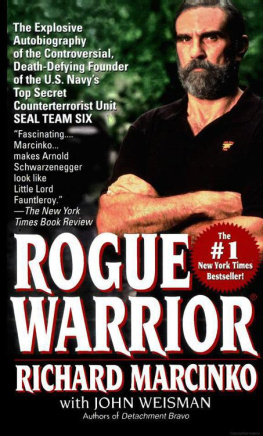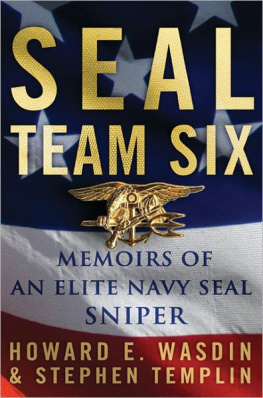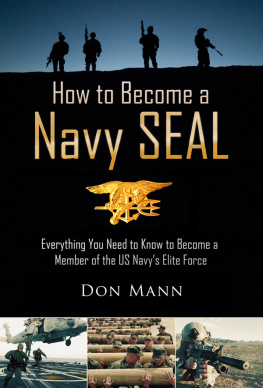ROGUE WARRIOR
By
Richard Marcinko
IN THE HISTORY OF THE U.S. NAVY THERE HAS NEVER BEEN an unconventional warrior quite so unconventional as Dick Marcinko.
Perhaps the best indication of his capabilities was that in August 1980, at the age of thirty-nine, Marcinko, then a commander, was picked by the Chief of Naval Operations, Thomas Hayward, to design, build, equip, train, and lead what many believe to be the best counterterror force in the world, SEAL Team Six.
His route to the command of Six was circuitous. A renegade high-school dropout from a broken home in the Pennsylvania coal fields, Marcinko made the Navy his career and special warfare his obsession. As a gung-ho young SEAL officer in Vietnam, he operated behind enemy lines. While others dug in behind barbed wire and sandbags, Marcinko and his platoonin black pajamas and barefoot, using captured Soviet weapons and ammohunted the Viet Cong deep inside their own turf.
During one six-month period, Marcinkos SEALs performed an incredible 107 combat patrols, with more than 150 confirmed VC killed and 84 captured. During two tours in Vietnam, Marcinko won the Silver Star, four Bronze Stars with Combat V, two Navy Commendation Medals, and the Vietnamese Cross of Gallantry with Silver Star. As a Naval attache in Cambodia in 1973 and 1974, Marcinkos exploits included bodysurfing behind a patrol boat on the Mekong River during a Khmer Rouge ambush. He spent 291 days in combat in Cambodia, and was awarded the Legion of Merit for his actions.
The Navy was Dick Marcinkos life. It gave him an educationa high-school diploma, a B.A., even a masters in international relations. It also gave him a deadly trade: unconventional warrior. Ambushes, booby traps, exotic weapons, high-altitude parachute drops, underwater infiltrationsMarcinko is a virtuoso of them all.
The day he assumed command of SEAL Team Six, CNO Haywards orders to Marcinko were briefalmost to the point of curtness. He was told he had less than six months to bring the new unit on line. He was ordered to get the job done, whatever the personal or professional cost. Dick, you will not fail, is what Hayward said.
To achieve that goal, Marcinko rewrote the rule book on unconventional warfare, and its training. He cut corners. He stepped on toes. He wheedled and cajoled. He threatened and occasionally he terrorized. His sin was that he believed the end was worth the means; his hubris, that he thought he could get away with it.
Indeed, if were talking heroic here about Dick Marcinko (and I believe we should be), he is heroic in the classic sense of the word: Dicks warrior hubris was too much for some of the Pentagons Olympians, and so a few Navy technocrat gods brought him down as an example to others.
The specific tragic flaw that caused Marcinkos fall was one of his most gallant qualities: loyalty. His loyalties always lay with the men under his command, rather than with the Navy system of which he was a part.
Marcinko has never been reluctant to admit as much. Soon after we met, I asked him if the litany of transgressions against the system the Navy accused him of committing were true.
Absolutely, he said. Guilty as charged. Guilty of preaching unit integrity above other values. Guilty of putting my men before bureaucratic bullshit. Guilty of spending as xlv much money as I can get my hands on to train my men properly. Guilty of preparing my men for war instead of peace.
Of all these things am I indeed guilty. Mea culpa, mea culpa, mea maxima fucking culpa.
Dick Marcinkos story is as exciting as any piece of fictionbut it is more than that. It is the provocative chronicle of an American heroa warrior whose legacies still live on, through the men he trained, and led, and inspired.
John Weisman Chevy Chase, MD
October 1991 xv
Part One
GEEK
Chapter 1
January 1981
IT WAS A BIG FIRST STEPNINETEEN THOUSAND FEET between the soles of my boots and the scrubby junglebut I didnt have time to think about that. The green light was on and the jumpmaster was pointing vaguely in my direction, so I blew a polite kiss at him and went out for a walktook a stroll off the deep end of the C-130s greasy ramp and dove into the nighttime sky. Just the way Id done it more than a thousand times before.
The ice-cold slipstream punched at me as the blacked-out plane disappeared overhead. I looked down. Nothing. Almost four miles to the groundtoo far to see anything yet, or for anyone down there to have heard the plane.
I looked around me. Zippo. What had I expected? To see my men? That would be impossible, too, of course. We were showing no lights, carried nothing reflective, and were all dressed in dark camouflage tigerstripes, invisible in the blackness above our objective, Vieques Island, in the Caribbean far below.
I clenched my fist and tucked my elbow in silent triumph.
Yes! Right on! The first eight seconds of this operation had gone absolutely perfectly. So far, we were ahead of the curve.
I checked the altimeter on my wrist then pulled the rip cord.I sensed my chute slip out of the backpack and felt it separate.
I was yanked skyward by the harness in the bungeecord way youre always bounced by a chute. Then all of a sudden I veered sharply to my right and began to spiral wildly, uncontrollably, toward the ground.
So much for perfection. I looked up. One of the cells of my sky-blue silk canopy had collapsed in the crosswind. I tugged on the guidelines to shake it out and fill the chute with air, but couldnt make it happen.
It didnt help that I was carrying almost a hundred pounds of equipment strapped to a specially built combat vest or attached to my fatigues. The weight was a problem in the thin air during HAHOhigh altitude, high openingjumps.
Most of what I carried was lethal. There was my customized Beretta 92-SF in its thigh holster, along with eleven clips of ammo165 rounds of hollow-point Hydra-Slick, custommade hot loads that could literally blow a mans head off.
Hanging from a strap attached to my shoulder was a specially modified HKHeckler & KochMP5 submachine gun and 600 rounds of jacketed hollow-point in 30round magazines.
Then there were the other goodies: flash-bang grenades and thunder-strips to disorient bad guys; strobes and light-sticks for guiding choppers into a drop zone. Wire snips for cutting through fences. And I carried a selection of the miniaturized communications stuff wed developedstrapped to my waist was a secure Motorola walkie-talkie (it came with lip mikes and earpieces so we could talk and listen to each other while moving. No Secret Service whispering into our shirt cuffs for us).
In the upper right-hand pocket of my combat vest was a satellite transceiver, a SATCOM unit about the same size as a cellular phone-On it I could talk to my boss. Brigadier General Dick Scholtes, who ran the Joint Special Operations Command, back at his Ops Center at Ft. Bragg, North Carolina, as clearly as if I were in the next room instead of almost two thousand miles down the road.
I laughed out loud. Maybe I should punch up Scholtes now.
Hey, General, Im calling about this little momentary snag thats developed. Dickies about to go squish.
Another two air cells in the parasail collapsed and the chute folded in half. Okay, so it screwed up. No problem. Id rehearsed this move maybe eighty, a hundred times during practice jumps. I did a cutaway, jettisoned the faulty canopy, then yesumed free-fall. Fifteen thousand feet and cruising.
Five seconds later I yanked the cord on my second chute. it started to open nicely. Then it developed a fissure, folded in half, and collapsed just like number one, and the crazy corkscrewing began all over again.
I didnt have any more backups.
I tore at the lines with both hands to open the parasail to its full width, screaming profanities into space.
Next page







